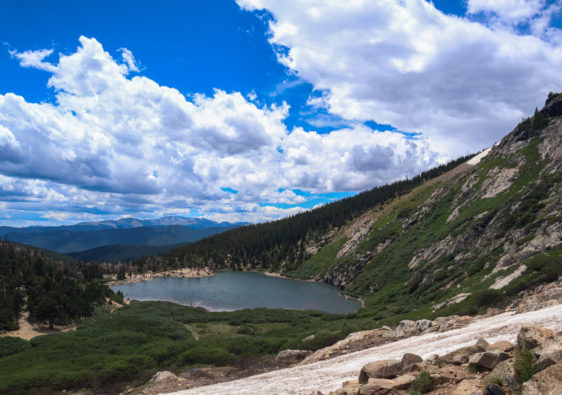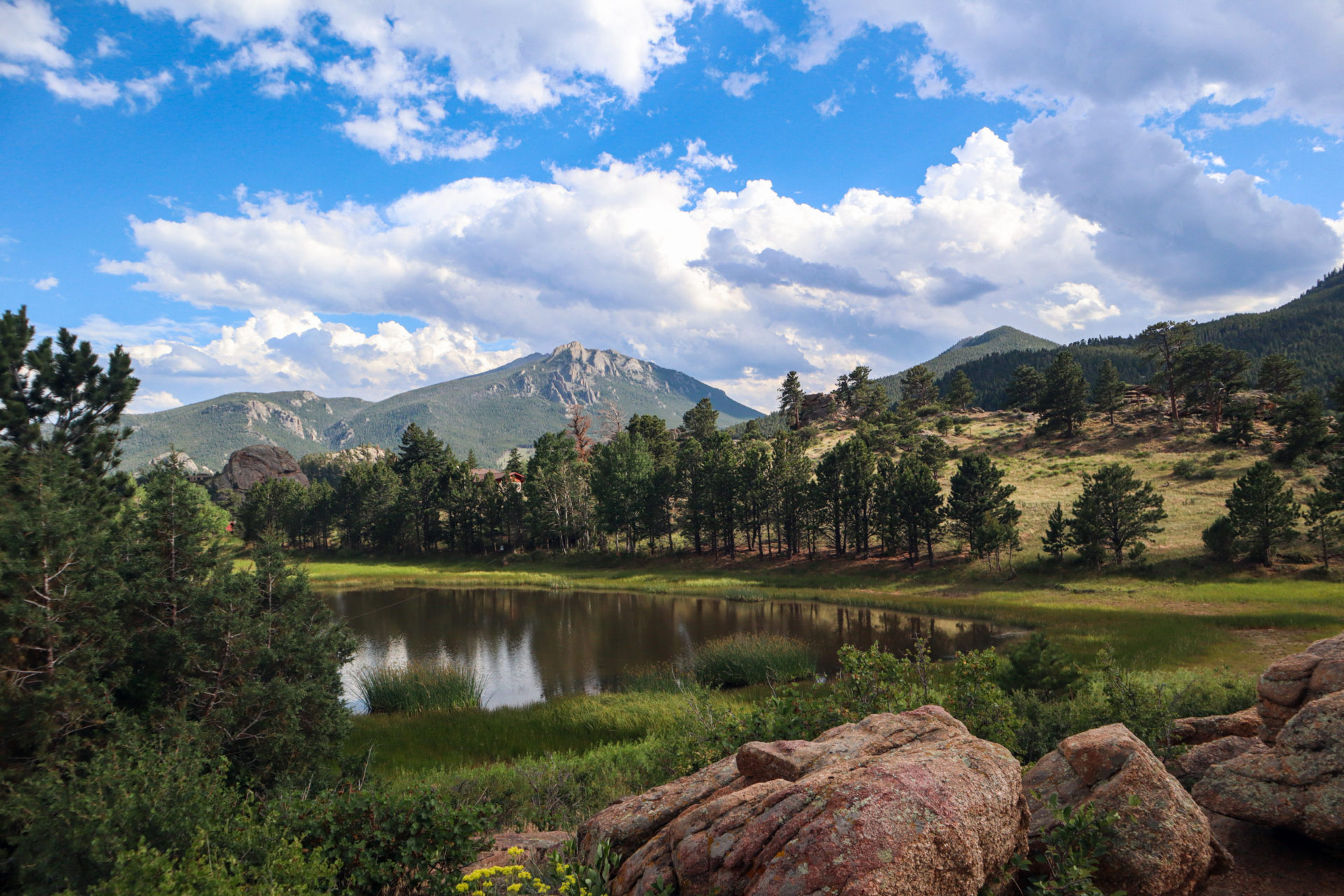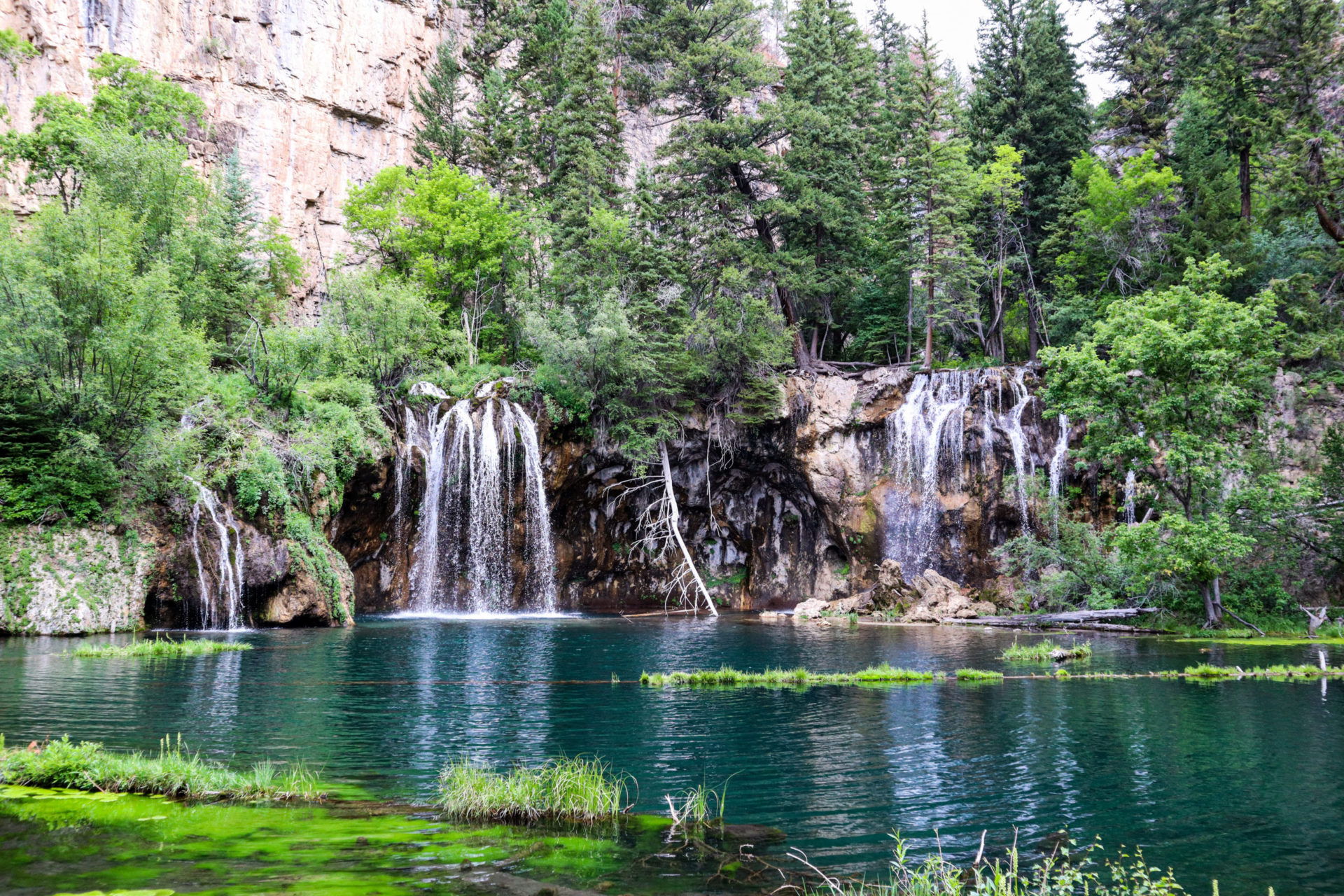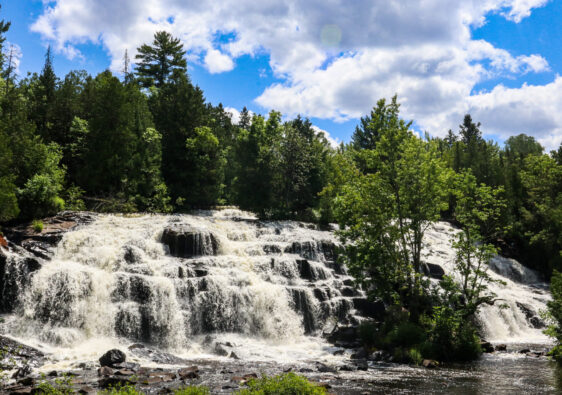You only have a couple days to explore Hocking Hills in Ohio. Where do you go? Keep reading for the best waterfalls and hikes to explore.
Table of Contents
- Preparing to Visit Hocking Hills in Ohio
- Hocking Hills State Park
- Other Hikes in Hocking County, Ohio
- Amazing Cabin Stay in Hocking Hills
- Hocking Hills 2-Day Hiking Itinerary
Preparing to Visit Hocking Hills in Ohio
Tips for Visiting Hocking Hills in Ohio
There are a few things you should know before planning your trip to Hocking Hills in Ohio.
- Plan ahead during peak travel months. Reservations for campsites and rentals will fill up quickly during the summer or fall season.
- Download maps offline or print out maps. I’ve also taken a screenshot of any maps I need. Service can be spotty, and you don’t want to end up lost.
- Start early in the day. In the summer this will help you beat the heat and the crowds. In the winter I recommend starting with the sun to maximize your daylight hours.
- Dogs are allowed, but not in all the parks in the area. They must be leashed.
- Watch for cliff edges. There are signs warning of cliff areas, and these shouldn’t be ignored. Watch any children or pets when exploring near these areas.
What season should you visit Hocking Hills in Ohio?
The right answer is all of them. But there are things to consider in each season.
Summer
Summer is the busiest season in Hocking Hills. You’ll want to plan ahead when booking rentals or campsites and start early in the day to avoid crowds and the heat. The waterfalls might not be flowing as heavily, so the best time to visit will be after rain. All the activities in the area like canopy tours and horseback riding will be open.
Fall
Fall is another popular season in Hocking Hills. The fall colors start in late September, peak towards the third week of October and end in November. Most establishments will still be open, but you should double check before visiting.
Winter
Winter is an underrated season to visit. I’d been dreaming of a winter trip to Hocking Hills when we went the first week of January. Due to an unseasonably warm winter, all the snow had melted, meaning rushing waterfalls like in the spring, but no winter wonderland.
But on a typical visit in the winter, you’ll find less crowds and everything transformed by the ice and snow. You’ll need to dress warmer and come prepared with microspikes and good traction, but it’s probably the best time of year to visit. A lot of the trees in the area are eastern hemlock, so it’s not like there’s no foliage in the winter either, as they keep their needles year-round. However, activities like the Butterfly Conservatory, canopy tours, and more won’t be open.
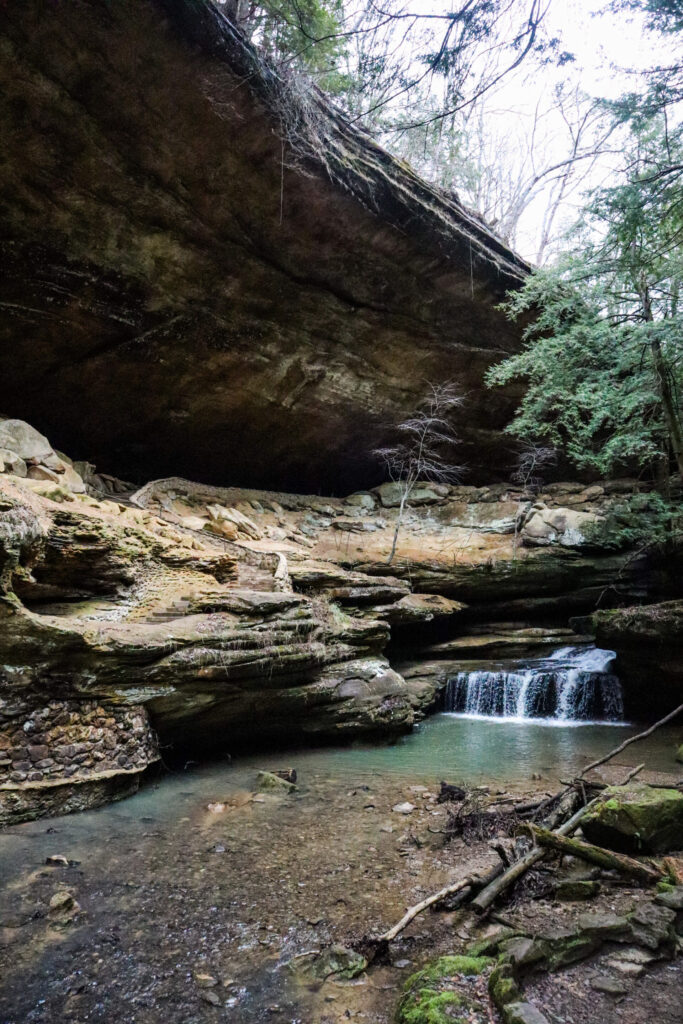
Spring
Spring would be another great time to visit Hocking Hills. With the snow melted, all the waterfalls will be rushing. This does mean there will be more mud though. There will be less crowds and the weather will be warming up. Another bonus will be any spring wildflowers. You might need to check if activities other than hiking are open for the season.
Packing List
Hiking Gear List and Recommendations
- Daypack (I have this one here from Mountain Warehouse)
- Sling Bag (I use this one here* from Kavu)
- Water Reservoir
- 10 Essentials (list linked here)
- Hiking Boots (I love these here from Columbia)
- Hiking/Camp Sandals (Check out these here* from Chaco)
- Base-layers
- Down Jacket
- Microspikes in the winter (find my favorite pairs on my “Winter Gear” list linked here*)
*this signifies an affiliate link. You can read more about what this means here.
Leave No Trace Principles in Hocking Hills
When visiting any natural area, it’s important to follow the principles of Leave No Trace. There are 7 Leave No Trace Principles that help to preserve and protect that natural spaces that we visit. In case you’re not familiar, they go as follows:
- Plan ahead and prepare
- Travel and camp on durable surfaces
- Dispose of waste properly
- Leave what you find
- Minimize campfire impacts
- Respect wildlife
- Be considerate of others
If you’d like to read more about the 7 Leave No Trace Principles, visit this link here.
There are a couple of specific rules to keep in mind for your visit to Hocking Hills as well:
- Pets are allowed in most park areas (except the State Nature Preserves) but must be on a 6-foot leash.
- Stay on trails and obey any one-way trail directions. Staying on the trail helps prevent trail erosion but also protects you in any cliff areas.
- NO swimming or wading is allowed in waterfalls, creeks, or natural bodies of water (this is to protect both you and the wildlife)
- DO NOT carve into the rocks in Hocking Hills. Past carvings are either from a time where this was legal, tribal carvings, or from disrespectful visitors. Please be respectful during your visit.
Hocking Hills State Park
Ohio State Parks
Did you know that there’s no entry fees for Ohio State Parks? I had no idea until I visited. Coming from a state that prides themselves on their recreation passes from day passes to annual vehicle passes on your license plate, this was wild to me. But it’s also one more reason to follow leave no trace principles and be respectful of these beautiful places when you visit. Because it’s free. And if we all do our part to preserve these parks, we can keep it that way.
What do you need to know about Hocking Hills State Park?
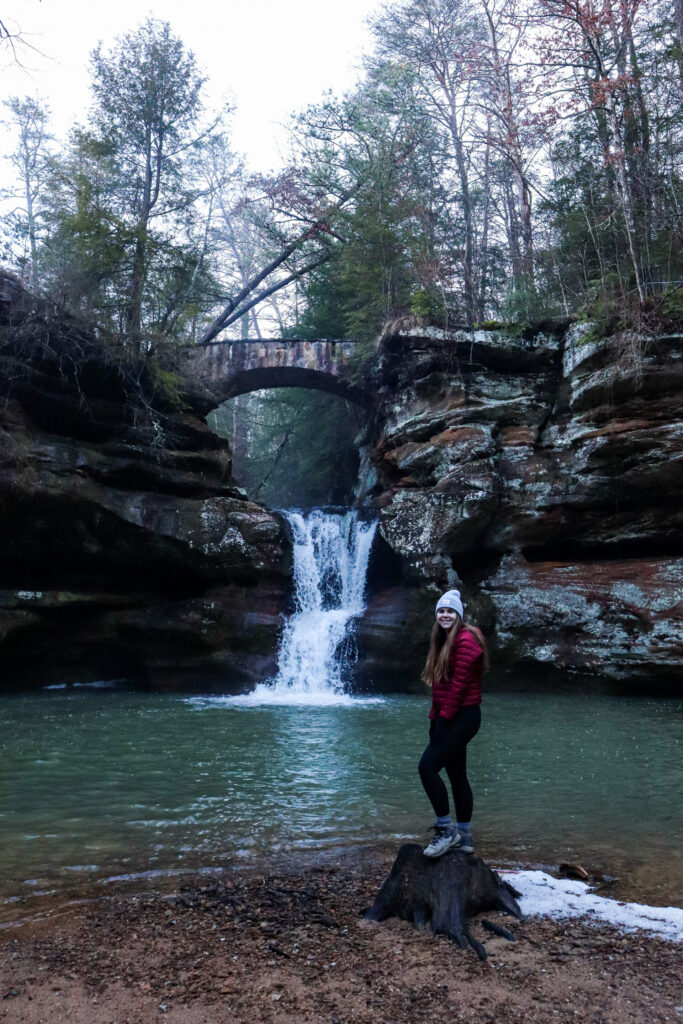
Hocking Hills State Park was established in 1924 on 146 acres and has continued to expand its property and facilities since then. Today it consists of over 2,356 acres, a range of camping and lodging options, and extensive facilities. There are over 25 miles of hiking trails just in the state park and countless opportunities for adventure in the area.
An important thing to know Hocking Hills State Park is that it’s very spread out. There’s not one park entrance that will take you where you need to go. And since cell service is spotty, I’d recommend downloading, printing, or screenshotting a map of the area. If you know the direction you need to go, main roads and roadside signs will probably get you to the right place.
Hocking Hills State Park also features a lot of one-way trails. This was originally set up for social distancing, but I think it’s been left in place to help prevent trail erosion. In theory, more people will stay on the trail if the flow of traffic is all one direction. All one-way trails are well-marked and easy to follow.
Upper Falls to Lower Falls via Buckeye Trail
If you want to see some of the most iconic spots in Hocking Hills, you need to start with this trail. This trail is part of the Buckeye Trail that winds throughout the entire state of Ohio. Along the way, you’ll see classic landmarks like the Upper Falls, Devil’s Bathtub, Old Man’s Cave, and Lower Falls. For this trail you’ll start at the Old Man’s Cave Trailhead at the Hocking Hills State Park Visitor Center. The actual trail starts at the left side of the parking lot when you pull in, closer to the road than the visitor’s center.
Navigating the Trail
Almost immediately down the creek you’ll see the beginning of the waterfall system as it drops into the gorge along Old Man’s Creek. You can look down to the right to see the 20-foot Upper Falls from above. The Upper Falls is probably one of the most iconic spots in Hocking Hills and it’s just as amazing in person.
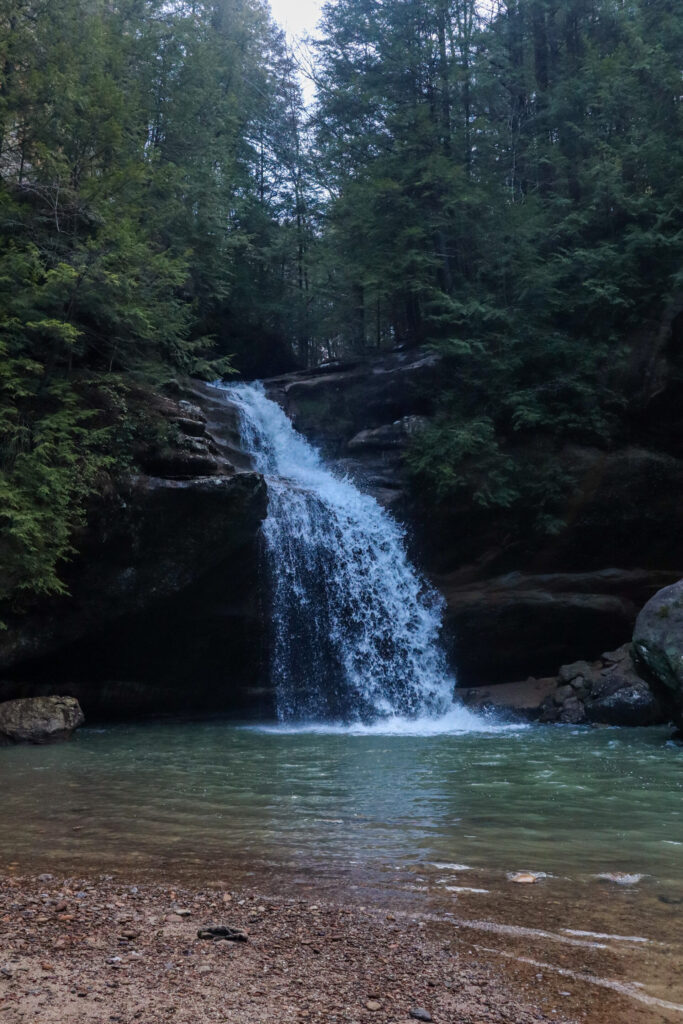
Continue down the trail to the third bridge, where you’ll find a formation called Devil’s Bathtub. Water swirls here before dropping over the cliff beneath the bridge. Shortly after you’ll reach the first trail intersection labeled C and should continue straight.
If you can take your eyes off the beautiful scenery along this route, the design of the trail is pretty amazing as well. There’s rock stairs cut into the side of the gorge and even tunnels through the rock. One of the more creative bridges features concrete slabs designed like stairs, but spaced out so you must step across a gap to each one. I’ve heard these compared to jumping across stones in a river. And if you look up here, you’ll find the A Frame Bridge looming above.
A final tunnel will take you into the Old Man’s Cave. I recommend really taking your time here because this cave is incredible. Off to the right you’ll find the Middle Falls and when we visited there was another small waterfall flowing from the top of the cave on the left. To continue to the Lower Falls, you’ll go straight through the tunnel instead of crossing the bridge over Old Man’s Creek.
After Old Man’s Cave, you’ll climb the stairs and descend back down to the Lower Falls. This waterfall is 30-feet tall and is definitely worth the extra distance. From there’ll you’ll head towards the exit.
Broken Rock Falls Detour
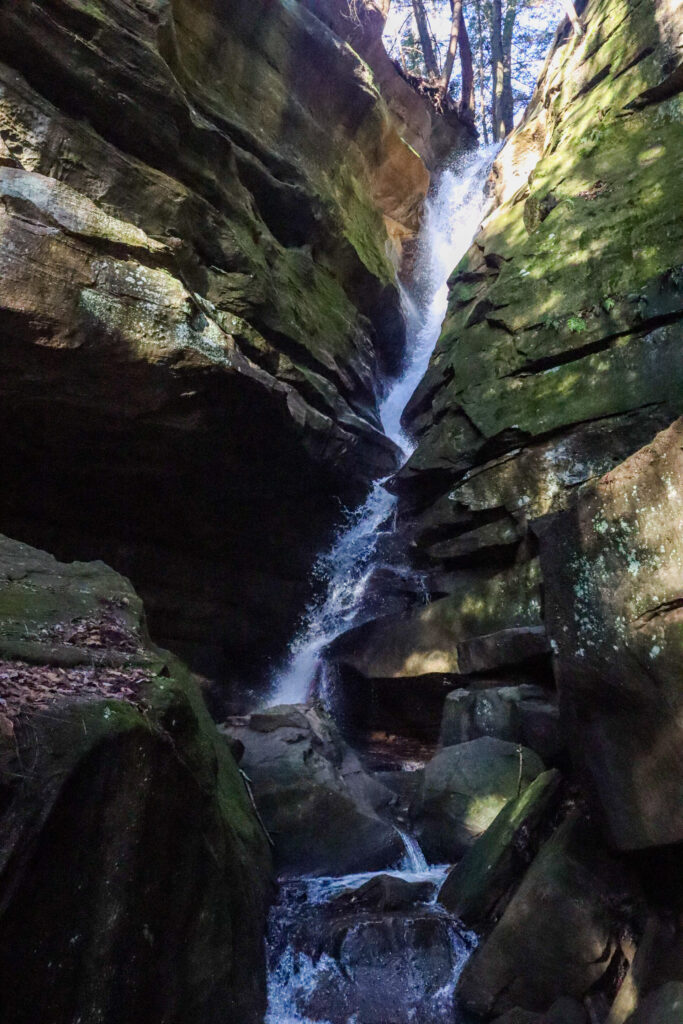
Once the trail takes you back to the edge of the cliff, you’ll see a sign pointing you towards the exit or towards Broken Rock Falls. This is at intersection Y.
I highly recommend that you head towards Broken Rock Falls. It’s a short 0.2 mile detour to an incredible waterfall. This trail is an out-and-back so you’ll be back on the main trail in no time. There are 91 steps leading to the falls, so it’s not the easiest section of trail, but it’s beyond worth it.
I’m not sure how tall this waterfall is, but it feels massive when you stand near it. And there’s even steps that lead you down to the pool below the falls. I could feel the mist coming off the falls when I stood here.
Once you’ve soaked in this waterfall, head back the way you came. The exit trail from Old Man’s Cave will take you up a spiral staircase and back to the Hocking Hills Visitor Center.
Trail Details
- Distance: 1.4 miles
- Elevation Gain: 164 feet
- Difficulty Level: Moderate
- Route Type: Loop
Cedar Falls
There’s a separate trailhead for Cedar Falls. It can be accessed from the Buckeye Trail that starts at the Hocking Hills State Park Visitor Center, but this way is more direct.
Steep stairs will take you down into the gorge from the trailhead. Turn right at the bottom of the hill and the trail is easy to follow from there. It will take you along Queer Creek, which is a beautiful turquoise color.
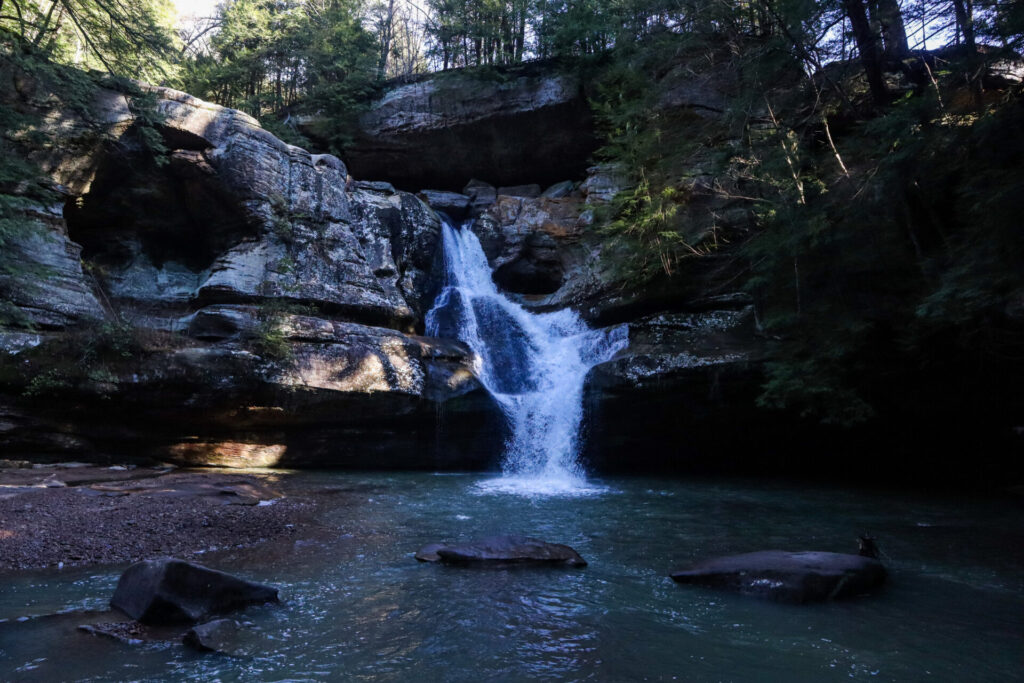
It won’t take you long to reach Cedar Falls. This waterfall flows 50-feet down into a turquoise pool. By water volume, this is actually the largest waterfall in the Hocking Hills area. It’s best observed after a lot of rain or in the spring after the snow melts.
From the waterfall, the loop trail will direct you back out of the gorge.
Trail Details
- Distance: 0.4 miles
- Elevation Gain: 95 feet
- Difficulty Level: Easy
- Route Type: Loop
Ash Cave Fire Tower
The Ash Cave Fire Tower is a great stop that offers 360-degree views of the surrounding area. If you visit Hocking Hills in the fall, you can’t miss this stop.
The tower is 80-feet tall and was originally built in 1934. Fire towers used to be staffed and equipped to identify wildfires. After surveillance began by airplanes, the fire towers were closed. The last one in Ohio closed in 1978.
Today visitors can climb to the top at their own risk. I would warn against climbing when it’s very windy or during a storm. Or when there’s already a lot of people on the tower. It’s a little scary to climb, but worth it for the view.
Ash Cave
This was one of my favorite stops on our visit to Hocking Hills in Ohio. A paved ADA-accessible trail will take you down the first part of the trail to Ash Cave. It ends at a great lookout of the cave.
From there the trail continues unpaved through Ash Cave. Ash Cave is horseshoe-shaped and measures 700-feet from end to end. A waterfall flows over the edge of the cave, cascading down 100 feet. From the cave, you can either loop back the way you came, or go back on the Ash Cave Rim trail. This is what we did on accident. The trail is pretty muddy in sections here after rain or snowmelt.
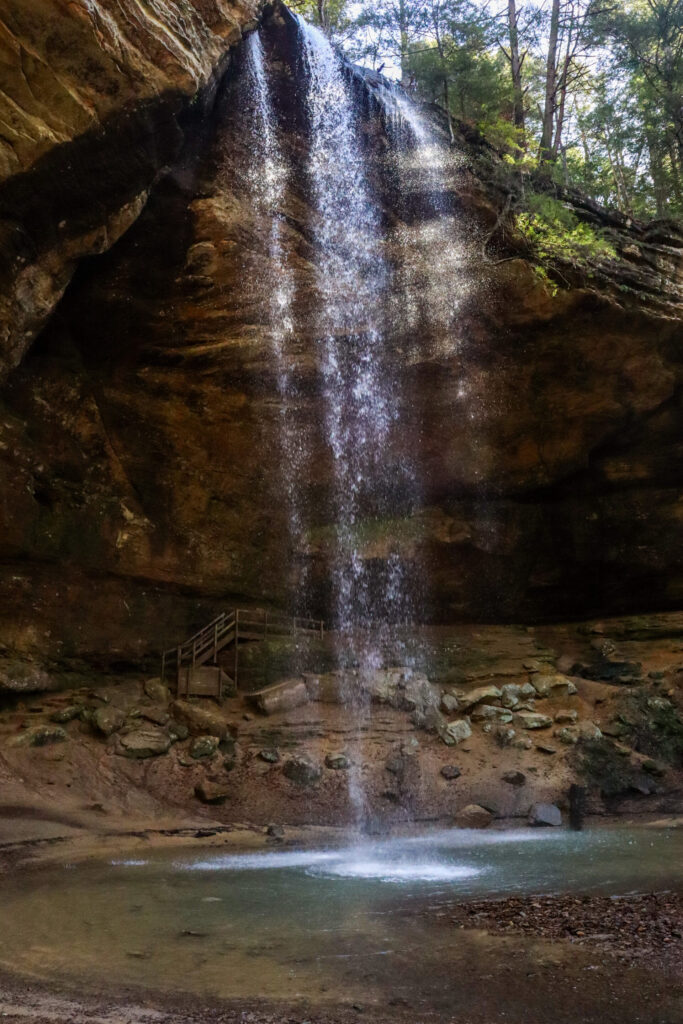
On my next visit, I’d love to take the full rim trail and see all of Ash Cave from above. But I highly recommend experiencing what it’s like inside this incredible cave.
Trail Details
- Distance: 0.5 miles
- Elevation Gain: 111 feet
- Difficulty Level: Easy
- Route Type: Loop
Whispering Cave
For anyone using Alltrails to find hiking in Hocking Hills, Whispering Cave is a tricky one to find. We used the trail referred to as Hemlock Bridge and Whispering Cave for reference on Alltrails but didn’t find any parking where it directed us to. We ended up parking at the Hocking Hills State Park Dining Lodge.
From there you’ll walk around the deck of the building, down the stairs, and down the sidewalk to the left. The trail starts in the back of the lodge, taking you down the stairs cut into the hillside. This section is steep, so be prepared for the burn on the way back up.
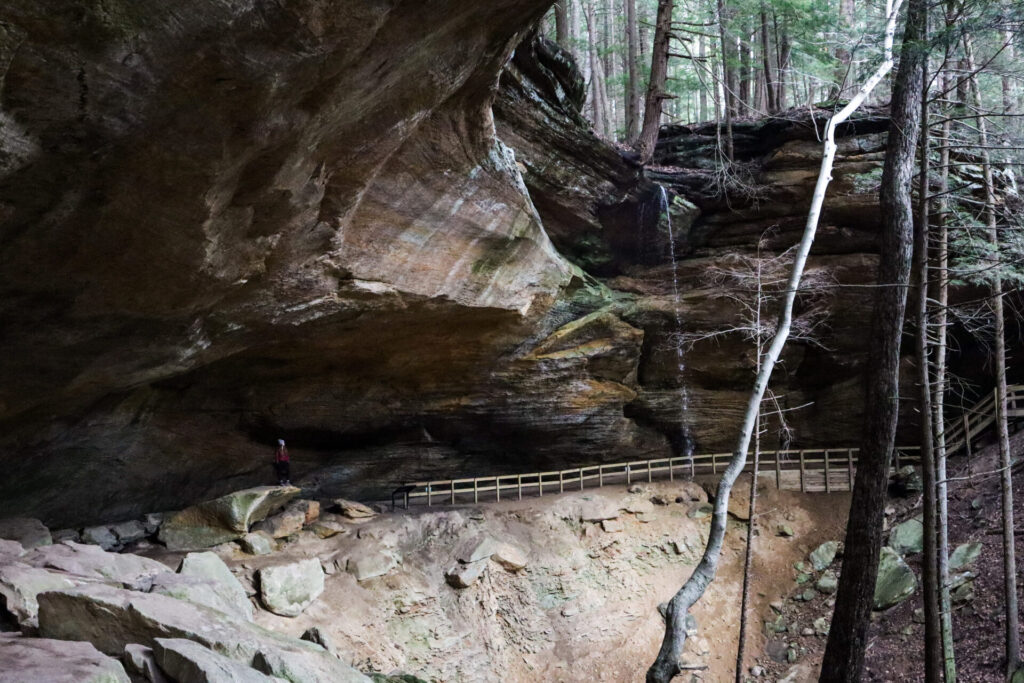
At the first trail intersection, you’ll continue to the right. This trail starts to hug the cliffside by the time you reach the second intersection. To get to Whispering Cave you’ll want to continue straight along the cliff. The other trail will take you to the Hemlock Bridge, which is a suspension bridge built to connect the Whispering Cave to the Buckeye Trail system.
The Whispering Cave isn’t far down the trail. You can walk through the entire cave and take in its 105-foot waterfall that cascades from the top.
This is one of the few two-direction trails in Hocking Hills State Park, so you’ll turn around at the sign that designates the end of the trail, and head back out the way you came.
Although Hocking Hills in Ohio is known for its crowds and busy trails, this is a newer trail that not many people know about. You definitely can’t miss this cave on your trip.
Trail Details
- Distance: ~.75 miles
- Difficulty Level: Moderate
- Route Type: Out and Back
Rock House
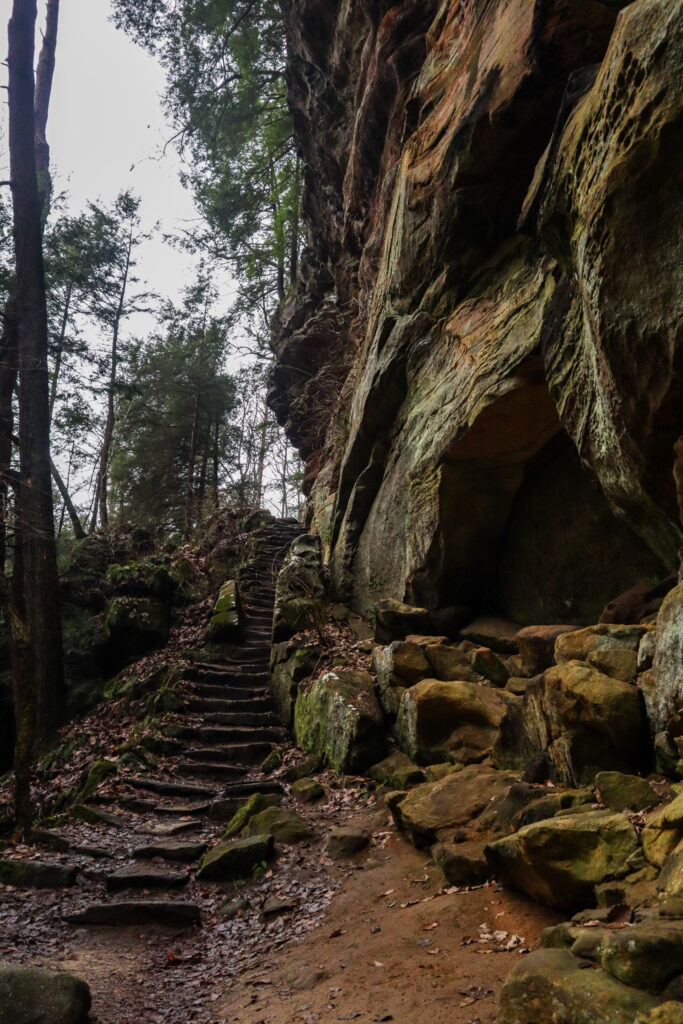
The Rock House in Hocking Hills is unique because it’s the only true cave in the park. It has a tunnel-like structure cut through the Blackhand sandstone that’s almost 200-feet long. The cave has ceilings that are 25-feet tall and is between 20-30 feet wide.
I was thrown off by how many carvings are in the rocks here but found out that many of them are tribal or from a previous time in history when this was allowed. Visitors are not permitted to carve into the rocks today.
The trail down to Rock House is a little steep but manageable. As you approach the cave, you’ll begin to hear an eerie sound. Rock House has several window-like structures where you can enter the cave. I went in despite the sounds coming from inside and found so many pigeons. Their coo echoes off the cave walls and the sound of their wings sounds more threatening than just a pigeon. I was a little afraid of getting dive-bombed, so I didn’t spend much time inside the cave, but it was still amazing to see.
Down the trail from Rock House, the bridge across the creek is out. There’s an alternate route here that may be more difficult to cross in higher water levels. The next section of the trail is steep and may be muddy in the right weather. It’s definitely a calf-burner to climb back out of this gorge.
Trail Details
- Distance: 0.8 miles
- Elevation Gain: 203 feet
- Difficulty Level: Moderate
- Route Type: Loop
Cantwell Cliffs
Cantwell Cliffs Loop is a great opportunity to avoid the crowds while exploring Hocking Hills in Ohio. It’s the most remote area of the park, close to 20 miles from the main Old Man’s Cave region of Hocking Hills.
There are a few miles of trails to explore here, but I recommend at least doing the outer loop. The beginning of the trail will take you down through a narrow break in the rock into the gorge. After taking the stone steps down through a section offensively named “The Fat Woman’s Squeeze”, the first landmark is a cave with a stunning waterfall. From here I recommend taking the trail toward waypoint E to explore the gorge section of the trail.
You’ll cross a stream and see another waterfall before climbing up some steep stairs to the rim trail. Follow the one-way trail directions to navigate the rest of the trail towards the exit. This trail also gets muddy after any recent rain or snowmelt, so wear proper footwear and watch for cliff edges.
Trail Details
- Distance: 0.9 miles
- Elevation Gain: 249 feet
- Difficulty Level: Moderate
- Route Type: Loop
Other Hikes in Hocking County, Ohio
It is important to know that both Conkle’s Hollow State Nature Preserve and Rockbridge State Nature Preserve detailed below do not allow dogs.
Conkle’s Hollow Gorge Trail
While Conkle’s Hollow State Nature Preserve is not part of Hocking Hills State Park in Ohio, it is a stunning place to explore on your trip. Conkle’s Hollow is the deepest gorge in the area, with cliffs towering 200-feet above the bottom of the gorge. As you hike along the trail, it also narrows until it’s only about 300-feet across.
There are two trail options at the stunning Conkle’s Hollow Natural Area: the gorge trail and the rim trail. While the rim trail is on my list for next time and would be breathtaking in the fall, we opted to explore the gorge trail on our visit.
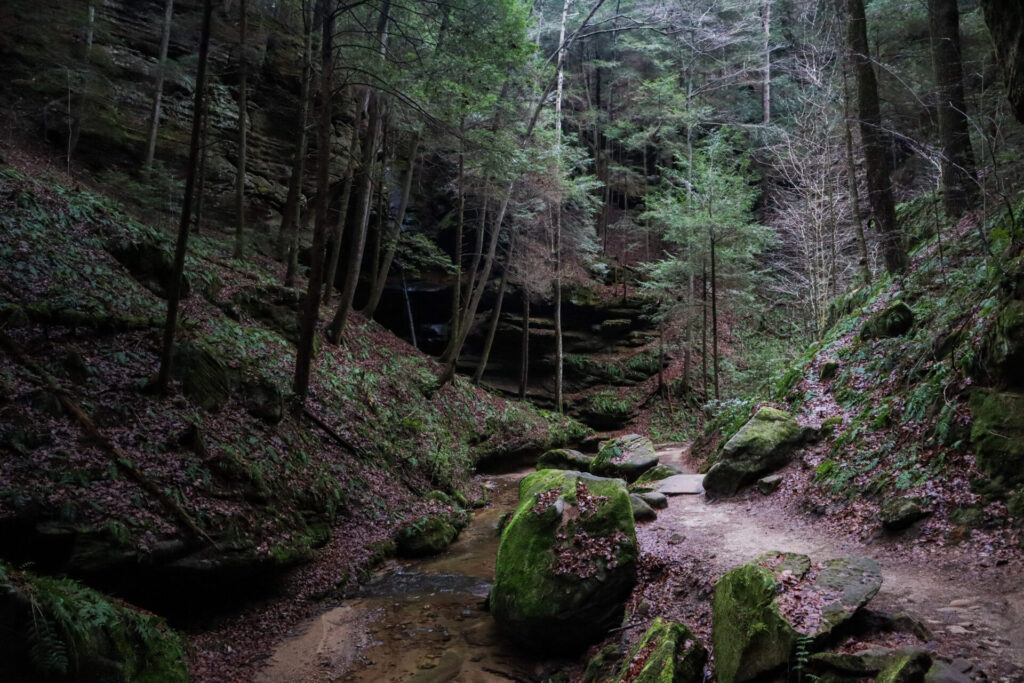
The first section of the trail is paved and ADA-accessible as it crosses the river and continues down the trail. Even during a snowless January, the gorge was so green and alive, with bright green ferns and eastern hemlocks lining the trail.
The first landmark to see along the trail is called The Grotto. This is a small cave that you can walk up into and get a closer look at. Further down the trail you will cross Stewart’s Bridge and enter the non-accessible part of the trail. The gorge narrows as you continue along the trail, and this next section was my favorite. You’ll see a waterfall off to your right called Reckworth Falls before reaching the very end of the gorge, where the Lower Falls flows into Conkle’s Creek.
Hike back out the way you came after soaking it all in. Please also note that hiking off trail in the creek or on the hillside is prohibited and subject to citation.
Trail Details
- Distance: 1.2 miles
- Elevation Gain: 72 feet
- Difficulty Level: Easy
- Route Type: Out and Back
Natural Bridge Trail
Did you know that Hocking Hills in Ohio also features the largest natural bridge in the state? This trail is located in Rockbridge State Nature Preserve.
When you pull in, you might be confused why you’re even there. The trail begins with a half mile trek alongside a large field before you even get to the woods. And maybe it’s because we had already tackled several miles of hiking that day, but the trail ahead isn’t an easy one.
Expect to climb up and down several steep hills. At the first intersection, continue straight for the most direct route. And at the final intersection you’ll veer off to the left. If you went the other way, there’s also a rock shelter you can visit. We didn’t have time to do this section during our trip, but I do recommend it if you have the time. The total mileage with this add-on is closer to 2.7 miles.
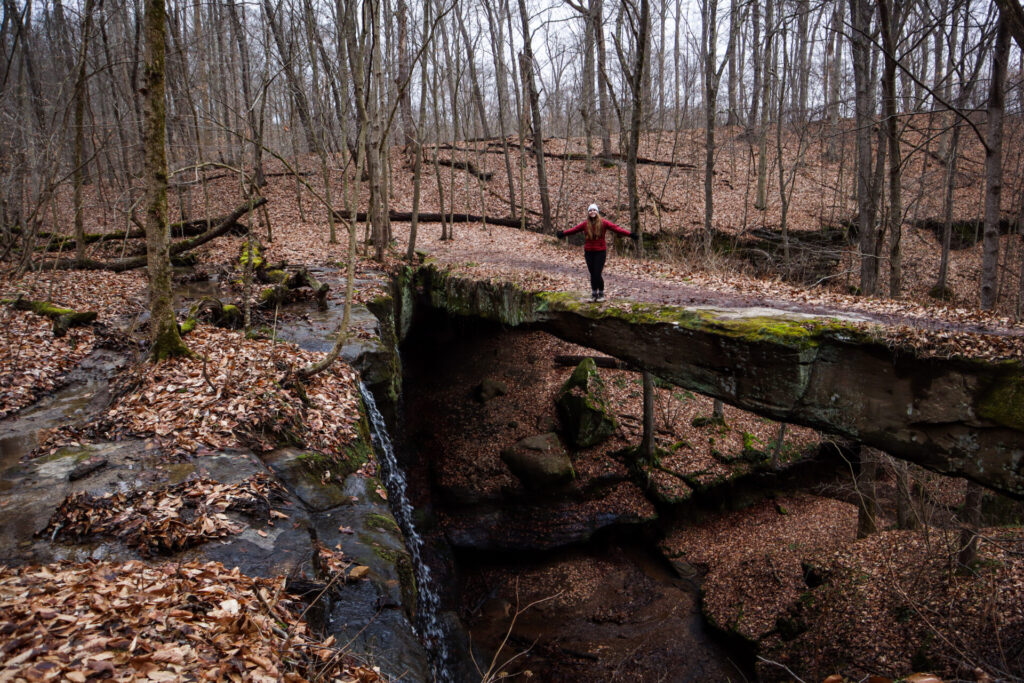
Down the trail further you’ll find the natural bridge. You can walk on it as long as you’re careful, and there’s an area where you can see what it looks like down below. Water runs over the edge of the rock here on its way to the Hocking River. There’s also a viewpoint of the river a little further down the trail. If you don’t plan to visit the rock shelter, just head back out the way you came.
Trail Details
- Distance: 1.6 miles
- Elevation Gain: ~400 feet
- Difficulty Level: Moderate
- Route Type: Out and Back
Amazing Cabin Stay in Hocking Hills
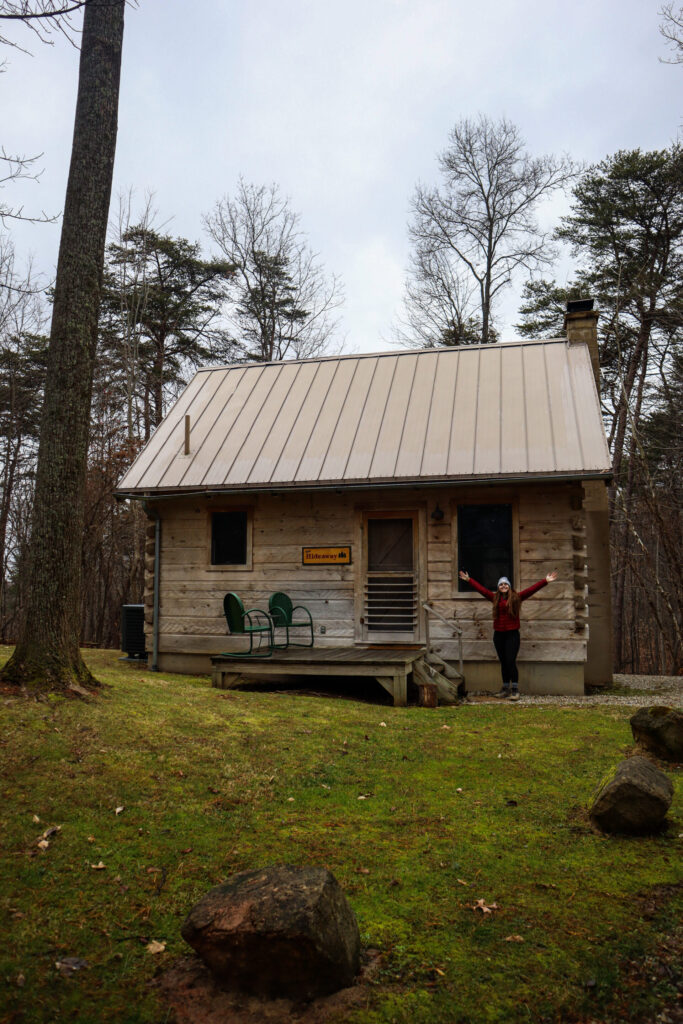
We stayed in The Hideaway Cabin at Summit Haven during our visit to Hocking Hills in Ohio (*hosted). This stunning cabin featured a loft bedroom, fireplace, hot tub, full kitchen, outdoor grill, firepit, aesthetic outdoor lighting, and any movie, book, or game you might need on your trip to Hocking Hills.
This family-owned cabin rental is located just a few minutes from the best of Hocking Hills and offers an affordable stay. The hosts are very helpful and provide everything you need for a great stay. They even have local coffee from the Hocking Hills Coffee Emporium.
If The Hideaway is booked during your dates, Summit Haven has other rental cabins including the Tanglewood, The Roost, and the brand-new Barn. These cabins are all different sizes, sleeping anywhere from 2-10 guests.
There are two things you’ll need to consider before booking your stay. There’s no Wi-fi other than in the Barn, so if this is a necessity to you, this might not be right place for you. And during the winter the road can be difficult to navigate without a 4×4 vehicle.
To book your stay at Summit Haven or learn more, visit their website here.
Hocking Hills 2-Day Hiking Itinerary
I’ve included a downloadable version of our itinerary below to help you plan your trip!
I will note that when we visited, we had a 6-hour drive and drove down the day before. So, we actually stayed for two days, explored the park for one full day, and then had another half day of exploring before we drove home.
Day 1: Hocking Hills State Park
- Upper Falls to Lower Falls via Buckeye Trail
- Cedar Falls
- Ash Cave Fire Tower
- Ash Cave
- Whispering Cave
Day 2: Hocking Hills State Park + Ohio State Nature Preserves
- Rock House
- Conkle’s Hollow State Nature Preserve
- Cantwell Cliffs
- Rockbridge State Nature Preserve
Download your free Hocking Hills 2-Day Hiking Itinerary below! It even comes with other recommendations for activities in the area.
Liked this post? Pin it for later!
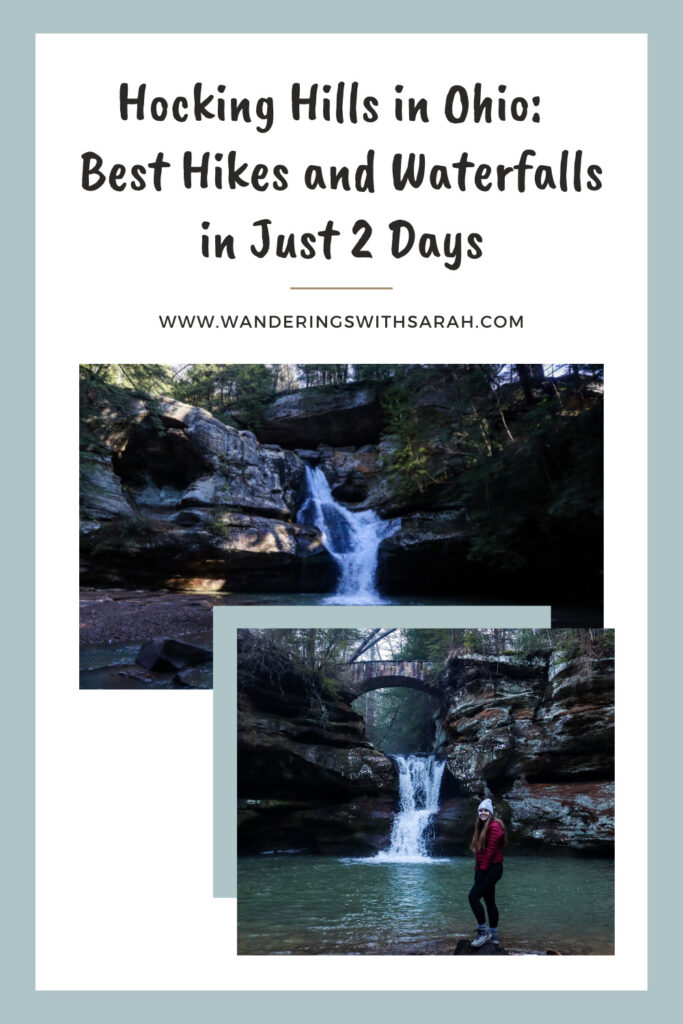
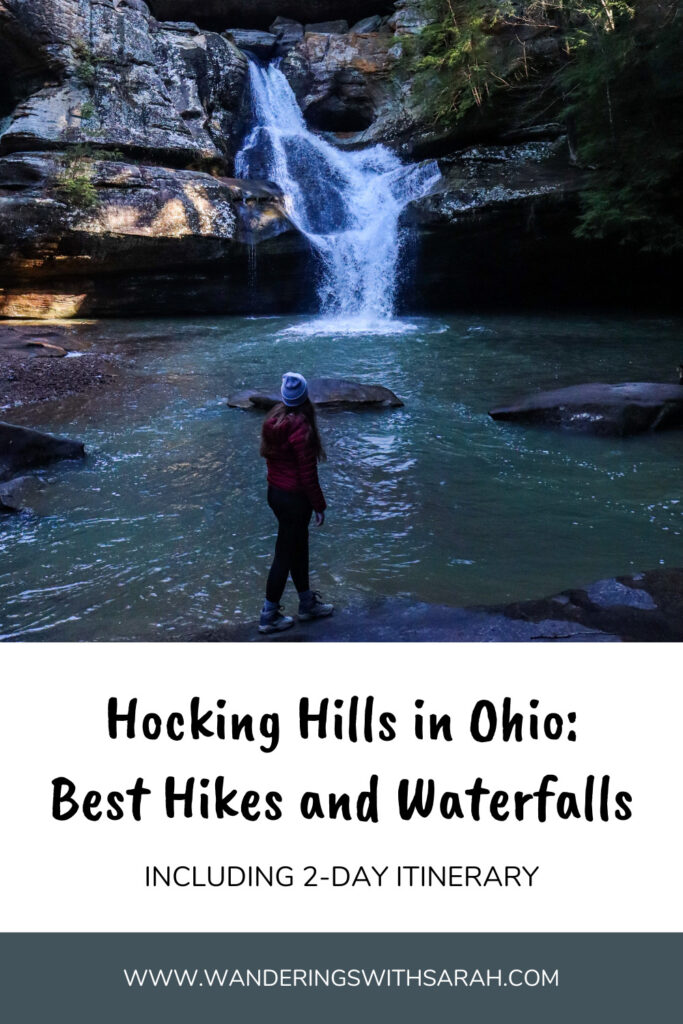
Other Blog Posts
- Best West Michigan Hiking Trails: The Story of My Senior Project
- How to Spend a Fun Morning at Tulip Time in Holland Michigan
- Hocking Hills in Ohio: Best Hikes and Waterfalls in Just 2 Days
Affiliate Link Disclosure: The symbol “*” signifies any links that are affiliate links. This means that I earn commission if you choose to buy something from these links. This comes at no additional cost to you and enables me to keep putting out content for you. If you choose not to purchase through these links, that’s fine too!
